|
|
|
the book of gates
please maximise your browser window
The Book of Gates is an Ancient Egyptian sacred text dating from the New Kingdom. It narrates the passage of a newly deceased soul into the next world, corresponding to the journey of the sun though the underworld during the hours of the night. The soul is required to pass though a series of "gates" at different stages in the journey. Each gate is associated with a different goddess, and requires that the deceased recognise the particular character of that deity. The text implies that some people will pass through unharmed, but that others will suffer torment in a lake of fire.
The most famous part of the Book of Gates today refers to the different races of humanity known to the Egyptians, dividing them up into four categories that are now conventionally labelled "Egyptians", "Asiatics", "Libyans", and "Nubians". These are depicted in procession entering the next world.
Translation and publication of the texts
Jean Francois Champollion provided the first description of the Book of Gates, along with some translations in his 13th letter from Egypt, dated 26th May 1829. He mostly referred to the reliefs detailed in the tomb of Ramesses VI for his translation. Despite Champollion's translations, the standard publication for many years was actually from an 1864 documentation by Bonomi and Sharpe, from their work on the sarcophagus of Seti I. In 1905, Edgar Wallis Budge described and translated the sarcophagus version, and made the comparison between the featured hours of the night and those of the Amduat. An incomplete version of the Book of Gates was discovered in 1908 in the tomb of Horemheb, and finally published in 1912. Since then, there have been later publications of the texts - Charles Maystre and the Russian Alexander Piankoff, who specialised in Egyptian philosophy and religion created a broader textual basis with their work of 1939-1962, which was published in English. In 1979 the Swiss Egyptologist Erik Hornung, a specialist in Egyptian funerary texts, published his version in German.
The basis of the Book of Gates
The text and images associated with the Book of Gates appear in many tombs of the New Kingdom, including all the pharaonic tombs between Horemheb and Ramses VII. They also appear in the tomb of Sennejem, a worker in the village of Deir el-Medina, the ancient village of artists and craftsmen who built the New Kingdom pharaonic tombs.
The goddesses listed in the Book of Gates each have different titles, and wear different coloured clothes, but are identical in all other respects, wearing a five pointed star above their heads. Most of the goddesses are specific to the Book of Gates, and do not appear elsewhere in Egyptian mythology, and so it has been suggested that the Book of Gates originated merely as a system for determining the time at night, with the goddess at each gate being a representation of the main star appearing during the hour.
The Book of Gates portrays the "gates" of the netherworld far more visibly and systematically than other similar compositions. It compares most readily with the "gates" referred to in the Book of the Dead, spells 144 and 145. The Ramesside Period Egyptians considered this an acceptable alternative for the Book of Gates in tombs that did not belong to pharaohs, such as that of Nefertari and others in the Valley of the Queens. In fact, "gates" referred to in the Book of the Dead and elsewhere have caused some confusion with the Book of Gates, even amongst some scholars. The concept of "gates" in the afterlife was a reoccurring theme in many of the books of the afterlife. The structure of the Book of Gates is very similar to that of the Amduat, with twelve nocturnal hours each divided into three registers. As in the Amduat, the first hour of the night has a special position with a structure that differs from the remainder of the composition.
The stages of the Book of Gates:
| Hour One |
As the sun god enters the ream of the dead, he is greeted by the collective dead, who are assigned the title of "gods of the west". rather than individual deities. Two stakes surmounted by a ram's head and a jackal's head both punish and reward those who dwell here.
|
| Hour Two |
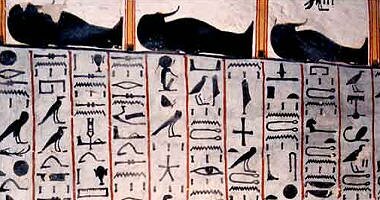 |
|
Upper register: Here are the dead who have followed Ma'at and who are now blessed. |
|
Middle Register: The barque encounters the "gods in the entrance". |
Lower register: Here are the dead who have not followed Ma'at and are now reprimanded by Atum. The "four weary ones" are shown here along with the "enemies".
|
| Hour Three |
Upper register: mummies are awakened from the dead and reanimated in their shrines. The Lake of Fire where the damned will meet flame. The blessed dead are provisioned from the same flames. |
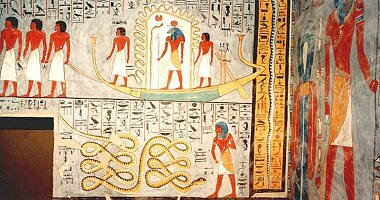 |
|
Middle register: The sun god is being towed along in the "barque of the earth", symbolising his entire journey through the depths of the earth. At the end of the register he is dressed in new white linens which symbolise of renewal. |
Lower register: Apophis the great serpent appears before Atum. Assisted by two other gods from the Ennead, Atum can overcome Apophis, his arch enemy.
|
| Hour Four |
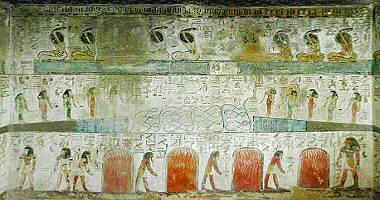 |
|
Upper register: Two bodies of water dominate the top register. They are called the Lake of Life, which is guarded by twelve gods with human bodies and the heads of jackals, and the Lake of Uraei. |
|
Middle register: Shrines containing mummies of the dead not yet risen, stand before the barque. The renewed life of these mummies occupies this whole hour. The passing of the hours is then represented by a coiled serpent indicative of time, and twelve goddesses embodying the hours. |
Lower register: An enshrined Osiris is protected on all sides by the gods of his entourage, whilst Horus cares for his deceased father. Osiris' enemies are punished in the fiery pits at the end of this register.
|
| Hour Five |
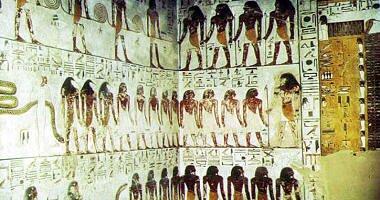 |
|
Upper register: The gods are portrayed with a surveying cord, because the deceased are allotted space in the form of fields. |
|
Middle register: Apophis the great serpent fiend, known as "the Retreater", must once again be impeded. Behind Apophis are the ba of the blessed dead. |
Lower register: The four "races" of mankind which include Egyptians, Asiatics, Nubians and Libyans are represented by four individual figures. They are assured existence in the afterlife and are placed in the care of Horus and Sekhmet.
|
| Hall of Judgement |
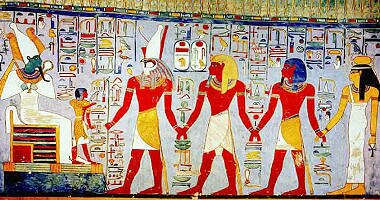 |
Just before the sixth hour is the portrayal of the Judgment hall. This is the only representation of the Judgment of the dead in any of the Books of the Netherworld. Osiris is enthroned on a stepped dais and the blessed dead stand on the steps of the dais. The enemies who are consigned to the "Place of Annihilation" lie beneath their feet.
|
| Hour Six |
Upper register: Gods holding forked poles keep the great serpent Apophis at bay. From his head emerge the people who he has swallowed earlier, and are now set free once more. A twisted double rope that represents time is being unwound from the pharynx of the god Aqen. |
|
Middle register: The dead corpse of the sun god is immediately in front of the barque and its towmen. It is invisible, and is being carried by gods whose arms also appear invisible because of their contact with the corpse. |
Lower register: Mummies are lying on a long, serpent-shaped bed so that they may participate in the union with the ba and the resurrection that it effects. A circular Lake of Fire inhabited by a cobra acts as a deterrent to all the enemies.
|
| Hour Seven |
Upper register: Two groups of blessed dead are shown. One group has baskets filled with grain, representing material provisions, and the other has the feather of Ma'at, symbolising their vindication at the Judgment of the Dead. They will exist until the end while sheltered by Ma'at, whilst the damned below are consigned to the Place of Annihilation. Osiris welcomes his new followers. |
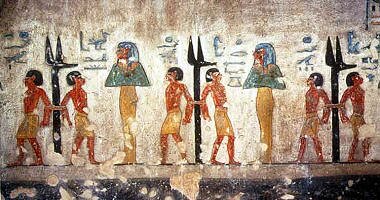 |
|
Middle register: Just before the solar barque, jackal headed "stakes of Geb" appear. Two enemies of the god are bound to each stake. Re consents to their torment by two demons. |
Lower register: The blessed who have followed Ma'at are gathering grain intended for their assured provisions. Others are provided with sickles for harvesting, whilst the rays of a revived sun induce abundant fertility.
|
| Hour Eight |
Upper register: Infinite time is depicted as an endless rope rolled out hour after hour. |
|
Middle register: The rope symbolising infinite time is also used as the towrope for the barque. "Lords of provision in the west" stand before the barque. They allocate provisions to the blessed and inflict evil on the enemies. |
Lower register: Mummies have turned over on their biers and are in the process of resurrection. Nearby, a council of judges protects them.
|
| Hour Nine |
Upper register: Before the souls of the blessed stand a group of figures who offer them bread and vegetables. |
|
Middle register: A rectangle of water contains the drowned. Four groups of deceased humans are floating in the primeval waters of Nun. The waters are refreshing them and they will be resurrected. Their noses breath in the air, and their ba will share existence with the blessed. |
Lower register: Twelve enemies, each bound in one of three different manners are inflamed by the Fiery One, a huge serpent who has been called forth by Horus for the atrocities they have committed against his father, Osiris. The children of Horus stand in his coils of this great snake.
|
| Hour Ten |
Upper register: The sun god is represented as a griffin and is followed by two serpents who help in the punishment of Apophis, as well as the other enemies. |
|
Middle register: The battle against the great serpent Apophis. Fourteen deities hold nets containing magical powers above their heads. Apophis is defenceless against their magic. The "old one", possibly Geb, then shackles the serpent's body. |
Lower register: Here the sun god is shown as a falcon, although he is also referred to as Khepri, the scarab beetle. He is connected to other figures by a continuous rope. The accompanying text describes the "emergence" and stresses that the journey is proceeding now towards the sky.
|
| Hour Eleven |
Upper register: Apophis and the enemies are bound and dismembered. A giant hand from the depths, grasps the rope that binds the great serpent and the enemies. |
|
Middle register: The face of Re travels in the barque. Before the barque there are stars, proclaiming the re-appearence of the sun god. |
Lower register: The oarsmen of the god, and the goddesses of the hours propel the barque into the eastern horizon.
|
| Hour Twelve |
Upper register: Gods carry sun disc in their hands - "the blazing light" and stars precede the appearance of the sun. Goddesses seated on serpents protect the solar "child" |
|
Middle register: Apophis lies before the barque, held in check by gods with knives and shepherd's crooks, so that he cannot inhibit the sunrise. Just behind him are four baboons, their arms raised in jubilation, who announce the sun god in the eastern horizon. |
Lower register: Crowns, symbolising power, are to be worn when leaving the underworld. Nurses for the "newborn" young sun are also represented. Osiris is mourned, for he must remain in the underworld. The final gate is guarded by two representations of Isis and Nephthys as cobras. Through here the sun god will emerge onto the dawn horizon.
|
| Final scene |
The final scene summaries the perpetual journey of the sun. Nun raises the solar barque from the depths of the primeval waters. In the barque, Isis and Nephthys embrace the sun in the form of a scarab beetle, pushing the sun disc up towards Nut. Nut is upside down, indicating the inversion of the sun's course. The underworld is the embodiment of Osiris. He surrounds this dark world with his curved body. All three areas of the cosmos are represented - the primeval waters, the height of the heavens and the depths of the earth. From above and below, arms embrace the sun, holding it aloft as it moves through the day. |
|
|
|






